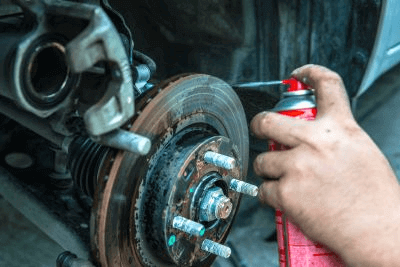What Is an Anti-rust Spray?

Anti-Rust Spray, as the name implies, is a spray that prevents rust.
It is often used on metal parts used in automobiles, motorcycles, bicycles, and other vehicles. Since a nozzle is provided, the spray can be applied with pinpoint accuracy to only the desired part of the component, making it easy for anyone to handle.
Anti-Rust Spray can be used to apply Anti-Rust treatment in places where large-scale painting work is difficult, such as high-temperature or corrosive environments. The price is relatively inexpensive and can be easily obtained by the general public at home centers or through mail order.
Uses of Anti-rust Sprays
Anti-Rust Spray is used to remove or prevent rust during maintenance rather than during industrial production of machine parts. Anti-Rust Spray may be applied during industrial production, but the difference is that the coating formed by Anti-Rust Spray is relatively thin and the treatment area is limited to a specified area only.
1. Industrial Parts
Anti-Rust Spray is most commonly used on machine tools. Machine tools contain frequently operated parts such as molds and jigs.
Rust on these surfaces can cause poor movement and operation problems, so rust prevention treatment is required during maintenance. To give a specific example, Anti-Rust Spray is used for precision machinery, which can be treated with pinpoint accuracy, because the area to be treated is very small.
2. Automobile Parts
Anti-Rust Spray is also used for the rust prevention treatment of automobile parts that we drive on a daily basis. Automobiles are often exposed to rain and humidity in the outdoor environment, so they are at risk of rust formation.
Rust-preventive treatments are applied during routine maintenance. Specific areas of the automobile that require treatment include the hood, inside the bumper, doors, and trunk compartment.
Principle of Anti-Rust Sprays
To understand the principle of Anti-Rust Spray, we must first understand how metals rust. Metals, with the exception of gold, rarely exist in nature by themselves. Iron, for example, is mined in the form of magnetite steel or brown iron steel.
Later, it is refined by human technology to become a single metal, which is then processed into metal parts for automobiles and other vehicles. However, the surfaces of cut and machined metals react easily with oxygen and water, making them susceptible to rust. Rusting not only deteriorates appearance, but also reduces strength and performance.
Anti-Rust Spray has two components: a rust inhibitor, which forms a thin film on the surface of the metal that shields it from oxygen and moisture; and a passive film, which is a thin layer of rust inhibitor, which is applied to the surface of the metal to prevent rust from forming. This passive film is an oxide but only a few nanometers thick, so it is transparent and maintains the luster of the metal surface.
The other is mineral oil, which allows rust-preventive ingredients to penetrate into the fine crevices of the metal. It can also lift fine rust already on the surface, which can be removed by wiping it off with a rag. Anti-Rust Spray can penetrate to the smallest areas and remove rust if it is only a small amount, and the rust-preventing agent also acts to protect the surface firmly to prevent rusting.
Types of Anti-rust Spray
In areas near the sea where there is a risk of salt damage or corrosive gases, general-purpose Anti-Rust Spray may cause rusting. In such places, Anti-Rust Sprays with ingredients formulated for seawater or corrosive gas environments are suitable.
By properly using the appropriate Anti-Rust Spray according to the situation, it will be possible to maintain the rust-preventing ability for a long period of time.